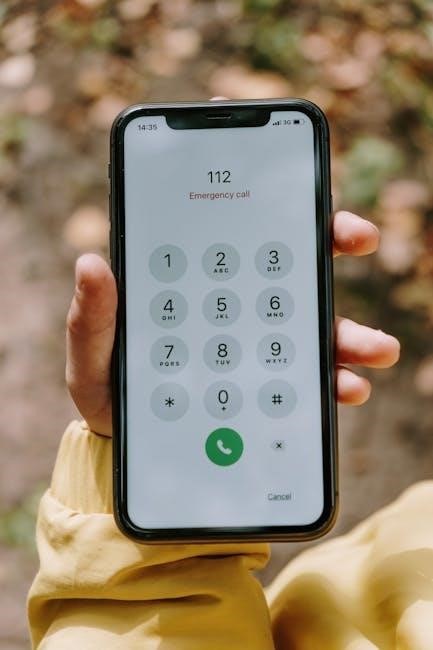This guide provides essential knowledge and practical steps for effectively using SOS signals in emergencies. It emphasizes preparedness, emergency kits, and response strategies to ensure safety and quick assistance.
1.1 Understanding the Importance of SOS Signals
SOS is a universal distress signal recognized globally, ensuring quick assistance in life-threatening situations. Its simplicity and international adoption make it a critical tool for emergencies at sea, in the air, or on land. Historically, SOS was first used in 1905 and became an international standard in 1908, revolutionizing emergency communication. Today, it remains vital, adapting to modern technologies like satellite systems and smartphones, ensuring timely help and saving countless lives. Understanding SOS is key to effective emergency response and preparedness.
1.2 Historical Background of SOS as an Emergency Signal

SOS originated in 1905 as a Morse code sequence ●●●−−−●●●, chosen for its simplicity and clarity. It became the international standard in 1908, replacing earlier signals. Initially used in maritime emergencies, SOS gained prominence during World War I and expanded to aviation and other fields. Its adoption marked a significant advancement in emergency communication, enabling faster response and saving lives. This historical evolution underscores SOS’s enduring relevance in modern emergency systems, including satellite and smartphone technologies.
1.3 Purpose of the SOS Safety Guide
The SOS Safety Guide aims to equip individuals with essential knowledge and practical steps for emergency preparedness. It covers traditional signaling methods, modern technologies, and personal safety strategies. The guide emphasizes creating emergency kits, mastering self-defense techniques, and understanding first aid. By fostering a culture of preparedness, it helps users recognize critical situations and respond effectively. This comprehensive resource ensures individuals are empowered to stay safe and secure in any emergency scenario, providing peace of mind and actionable solutions.
Traditional SOS Signaling Methods
SOS is the international Morse code distress signal, historically used with light, sound, or flags. Its simplicity and universality make it a reliable emergency communication method worldwide.
2.1 Morse Code and the Origins of SOS
SOS is the international Morse code distress signal, adopted in 1908 by the International Radiotelegraph Convention. It consists of three dots, three dashes, and three dots, representing a clear, recognizable pattern. Unlike other codes, SOS was chosen for its simplicity and ease of transmission, making it universally understood. This system became a standard for emergency communication, ensuring quick recognition and response in critical situations. Its origins highlight the importance of clear, efficient signaling in life-threatening scenarios.
2.2 Using Light Signals for SOS
Light signals are a reliable method for sending SOS in emergencies. The standard pattern involves three short flashes, followed by three long flashes, and ending with three short flashes. This sequence is easily recognizable and can be executed using flashlights, mirrors, or any light source. Light signals are particularly effective in daylight or when other methods fail. They provide a visual distress signal that can be seen from a distance, making them a crucial component of emergency communication strategies.
2.3 Audible SOS Signals (Whistles, Horns, etc.)
Audible SOS signals, such as whistles or horns, are critical for emergency communication. The universal pattern involves three short bursts, a pause, and three more bursts. This sequence is easily recognizable and can travel long distances. Whistles are particularly effective in poor visibility or noisy environments. They are simple, lightweight, and essential in emergency kits. Audible signals ensure help can be summoned quickly, making them a vital tool for survival and rescue in critical situations.
Modern SOS Technology
Modern SOS technology includes satellite-based systems, smartphones with emergency features, and vehicle systems like eCall. These innovations enable rapid response and connectivity in critical situations, enhancing safety globally.

3.1 Satellite-Based Emergency Response Systems
Satellite-based emergency response systems provide critical connectivity in remote areas without cellular networks. Google’s Pixel 9 phones now offer free emergency satellite SOS features, while Apple is considering similar services. These systems enable rapid location sharing and direct communication with emergency services, ensuring timely assistance. Satellite SOS technology is revolutionizing emergency response, especially in isolated regions, and is set to become a standard feature in future devices, enhancing global safety and rescue operations significantly.
3.2 Smartphones and Wearable Devices with SOS Features
Modern smartphones and wearables integrate SOS features for instant emergency alerts. Google’s Pixel 9 phones offer free emergency satellite connectivity, while Apple Watches enable quick SOS activation. These devices can share locations and alert emergency services or contacts. Some systems include optional video sharing for situational context. Such technologies enhance personal safety, especially in remote areas, providing users with peace of mind and rapid assistance during critical situations.

3.3 Vehicle Emergency Systems (e.g., eCall, SOS Buttons)
Vehicle emergency systems like eCall and SOS buttons provide immediate assistance in critical situations. These systems automatically detect crashes or allow manual activation, alerting emergency services and sharing location data. Some vehicles, such as those from Apple, integrate SOS features for rapid response. However, concerns like waiting times for SOS connections highlight the need for reliable systems. These technologies aim to enhance safety, ensuring timely help and reducing response times during emergencies, ultimately saving lives and preventing further harm.
![]()
Personal Safety and Emergency Preparedness
Personal safety requires preparedness, including emergency kits, self-defense techniques, and first aid knowledge. Stay informed, practice drills, and ensure quick access to help in critical situations.
4.1 Creating a Personal Emergency Kit
A personal emergency kit is crucial for survival in critical situations. Include essentials like water, non-perishable food, a flashlight, first aid supplies, and a communication device. Add important documents, such as ID and insurance cards, and a whistle for signaling. Regularly check expiration dates and customize the kit for individual needs. Ensure all items are easily accessible and stored in a durable, portable container. This preparation can make a significant difference in emergencies, helping you stay safe until help arrives.
4.2 Self-Defense Techniques for Critical Situations
Self-defense is vital in life-threatening scenarios, enabling individuals to protect themselves until help arrives. Key techniques include maintaining a strong stance, targeting vulnerable areas, and using objects as improvised weapons. Staying calm and aware of surroundings is crucial. Practice simple yet effective moves, such as palm strikes or elbow strikes, to create distance. These methods aim to neutralize threats and ensure personal safety, providing a lifeline in emergencies. Regular training enhances confidence and readiness, making self-defense a cornerstone of personal safety strategies.
4.3 First Aid Basics for Life-Threatening Injuries
First aid for life-threatening injuries requires immediate action to stabilize the victim. Control severe bleeding by applying direct pressure or using a tourniquet. Ensure the airway is clear and provide rescue breathing if necessary. Immobilize injuries like fractures or head trauma to prevent further damage. Stay calm and assess the situation thoroughly. Use basic first aid tools like bandages or splints to manage wounds. Always prioritize seeking professional medical help as quickly as possible to improve survival chances and recovery outcomes.

Workplace Safety and Emergency Response Plans
A comprehensive emergency plan is crucial for workplace safety, addressing evacuation routes, communication protocols, and first aid. Regular drills and updates ensure preparedness for fires, explosions, or injuries.
5.1 Developing a Comprehensive Emergency Plan
A comprehensive emergency plan is essential for workplace safety, outlining procedures for fires, explosions, floods, and medical emergencies. It should include evacuation routes, communication protocols, and first aid stations. Regular drills and employee training ensure preparedness. The plan must be tailored to the workplace’s specific risks and updated annually. Involving all staff in its development fosters a culture of safety and accountability, ensuring everyone knows their role during crises. This proactive approach minimizes risks and enhances response efficiency.
5.2 Special Procedures for Workplace Emergencies
Workplace emergencies like fires, explosions, or injuries require tailored procedures. Develop clear evacuation routes, fire extinguisher locations, and first aid stations. Train employees on using emergency equipment and chemical spill protocols. Establish a communication system for alerts and updates. Regular drills ensure preparedness. Include procedures for power outages, gas leaks, and natural disasters. Assign roles to team leaders for coordination. Regularly update procedures based on risk assessments and employee feedback to ensure effectiveness and compliance with safety standards. This ensures a swift and organized response during crises.
5.3 Training Employees on SOS Protocols
Regular training ensures employees understand and can execute SOS protocols effectively. Conduct drills to familiarize staff with emergency equipment and communication systems. Use real-life scenarios to simulate responses, ensuring clarity and confidence. Provide updates on new technologies, such as satellite-based systems or emergency apps. Encourage feedback to refine procedures and address gaps. Role-playing exercises help reinforce proper protocols. This comprehensive approach ensures employees are prepared to act swiftly and accurately during critical situations, minimizing risks and ensuring safety.

Family and Community Safety
Family and community safety involves teaching children SOS signals, organizing drills, and implementing neighborhood watch programs to ensure preparedness and quick response in emergencies.
6.1 Teaching Children About SOS Signals
Teaching children about SOS signals is crucial for their safety. Use simple, engaging methods like games or visual aids to explain the universal recognition of SOS. Role-play scenarios to practice sending signals, ensuring they understand its urgency. Explain the historical background of SOS in a child-friendly way, emphasizing its global use. This education empowers children to act confidently in emergencies, fostering a sense of preparedness and responsibility for their safety and others’.
6.2 Community Emergency Drills and Preparedness
Community emergency drills are vital for fostering preparedness and unity in crises. Organize regular drills to practice evacuation routes, communication plans, and resource distribution. Engage residents in simulations to build confidence and coordination. Ensure every household has an emergency kit with essentials like water, first aid, and flashlights. Collaborate with local leaders to educate on SOS signals and response protocols. Regular drills strengthen community resilience, ensuring everyone is ready to act swiftly and effectively during emergencies.
6.3 Neighborhood Watch Programs for Enhanced Safety
Neighborhood watch programs enhance safety by fostering community vigilance and collaboration. Trained volunteers monitor suspicious activities and report emergencies promptly. These programs prevent crimes and ensure rapid response to SOS signals. Regular meetings and drills strengthen preparedness and unity. Collaboration with local authorities ensures effective communication and resource allocation. By empowering residents to look out for one another, neighborhood watches create a safer, more resilient community, reducing risks and fostering a sense of security and shared responsibility.
Legal and Ethical Considerations
Understanding the legal implications of SOS usage is crucial to avoid misuse. Privacy concerns in emergency systems must be addressed to protect user data. Ethical use ensures trust and effectiveness in critical situations.
7.1 Understanding Legal Implications of SOS Usage
Using SOS signals legally is vital to avoid misuse and potential consequences. International laws recognize SOS as a distress signal, ensuring rapid response. However, misuse can lead to legal action. Modern systems, like satellite SOS, must comply with privacy regulations to protect user data. Ethical usage ensures trust in emergency responses, maintaining the integrity of SOS as a reliable tool for critical situations. Understanding these aspects is essential for responsible and effective deployment of SOS signals in emergencies.
7.2 Privacy Concerns in Emergency Response Systems
Emergency response systems, including satellite-based SOS features, raise privacy concerns. Location data and personal information must be protected to prevent misuse. Systems like Google’s Pixel SOS and Apple’s potential offerings ensure data security, but risks remain. Third-party services, such as RapidSOS, used by companies like Grubhub, must comply with strict privacy regulations. Balancing emergency response efficiency with user privacy is crucial to maintain trust and security in these life-saving technologies.
7.3 Ethical Use of SOS Signals
The ethical use of SOS signals is crucial to ensure they are employed responsibly and only in genuine emergencies. Misuse can lead to false alarms, wasting resources and eroding trust in the system. Companies like Grubhub and Google’s Pixel SOS feature emphasize proper usage to maintain integrity. Ethical guidelines encourage users to avoid unnecessary activations, respecting the system’s purpose of saving lives. Balancing accessibility with ethical considerations ensures SOS systems remain reliable and trustworthy for those in dire need.
Case Studies and Real-Life Applications
Real-life rescues highlight SOS effectiveness, such as Qualcomm’s satellite integration and Apple’s emergency features. Grubhub’s partnership with RapidSOS enhances courier safety, demonstrating industry-specific SOS implementations.
8.1 Successful SOS Rescues and Their Impact
SOS technology has proven lifesaving in numerous emergencies. Satellite-based systems, like those in Pixel phones, enabled rapid rescues during natural disasters. Google’s emergency SOS feature successfully alerted authorities, ensuring timely help. Grubhub’s partnership with RapidSOS enhanced courier safety, reducing response times. These real-world applications demonstrate the critical role of SOS systems in modern safety, highlighting their effectiveness in diverse scenarios and their impact on saving lives.
8.2 Lessons Learned from Emergency Response Failures
Emergency response failures highlight critical gaps in SOS systems. Delays in satellite SOS responses, like the 6-minute wait for car SOS features, underscore the need for faster protocols. Accidental activations, such as on Apple Watches, reveal the importance of user education. Additionally, reliance on satellite connectivity, like Qualcomm’s abandonment of Android’s feature, shows the need for robust alternatives. These lessons emphasize improving system reliability, user training, and backup communication methods to prevent future failures and ensure timely assistance in emergencies.
8.3 Industry-Specific SOS Implementations
Various industries have adopted tailored SOS systems to enhance safety. For instance, Google Pixel phones offer free emergency satellite connectivity, while Grubhub partners with RapidSOS to protect couriers. Apple’s SOS feature on iPhones and watches enables quick emergency contact. These industry-specific solutions demonstrate how SOS technology is adapted to meet unique needs, ensuring timely assistance and improving response efficiency across different sectors.
Future Trends in SOS Technology
Advancements include AI integration, enhanced satellite communication, and wearable devices. These innovations aim to improve response times and accessibility, ensuring safer emergency communication solutions globally.
9.1 Integration of AI in Emergency Response Systems
AI enhances emergency response by analyzing distress signals, predicting emergency types, and optimizing resource allocation. Advanced algorithms enable faster, more accurate assistance, reducing response times and improving outcomes. AI-driven systems can interpret vast data, detect patterns, and prioritize alerts, ensuring timely help. This integration revolutionizes SOS technology, making emergency response smarter and more efficient. AI’s role in emergency systems is pivotal, transforming how crises are managed and saving lives through intelligent, data-driven solutions.
9.2 Advancements in Satellite Communication for SOS
Recent advancements in satellite communication enable SOS signals to reach emergency services from remote areas. Google Pixel phones now offer free emergency satellite connectivity, while Apple considers pricing for similar features. Satellite-based systems provide global coverage, ensuring help is accessible even without cellular networks. These technologies enhance response accuracy and speed, critical for life-threatening situations. Satellite SOS integration in smartphones and wearables revolutionizes emergency communication, offering reliable assistance worldwide. This innovation bridges connectivity gaps, saving lives in isolated regions.

9.3 Wearable Technology and IoT in Safety
Wearable devices and IoT technologies are transforming safety by integrating SOS features. Smartwatches, like the Apple Watch, offer fall detection and emergency SOS, while IoT-enabled home systems can detect threats like fires or intruders. These devices provide real-time monitoring and instant alerts, ensuring rapid response in critical situations. Wearables also enable discreet SOS activation, such as pressing a button on a smartwatch or using voice commands. This seamless integration enhances personal safety and offers peace of mind for users worldwide.

Conclusion
The SOS Safety Guide serves as your lifeline, offering essential tips, strategies, and insights to stay safe in emergencies. Embrace preparedness and proactive safety measures for peace of mind.
10.1 Recap of Key SOS Safety Principles
The SOS Safety Guide underscores the importance of preparedness, quick action, and clear communication in emergencies. It balances traditional methods, like Morse code, with modern technologies such as satellite-based systems and wearable devices. The guide emphasizes assembling emergency kits, mastering self-defense, and understanding first aid. Community drills and workplace plans are highlighted as vital for collective safety. By integrating AI and IoT, future SOS systems aim to enhance response times and accuracy, ensuring protection for individuals and communities alike.

10.2 Encouraging a Culture of Preparedness
Fostering a culture of preparedness is crucial for community safety. Education and awareness campaigns play a key role in empowering individuals to recognize emergencies and respond effectively. By promoting regular drills, sharing downloadable checklists, and encouraging open discussions, communities can build resilience. Preparedness not only saves lives but also reduces panic during crises. It’s about creating a mindset where safety is a shared responsibility, ensuring everyone is equipped to act swiftly and confidently when emergencies arise.
10.3 Final Thoughts on Staying Safe in Emergencies
Staying safe in emergencies requires a proactive approach, combining modern technology with timeless preparedness. Tools like satellite SOS and smartphone features offer lifelines, but awareness and quick thinking are equally vital. By fostering a culture of readiness and leveraging available resources, individuals can navigate crises confidently. Remember, safety is a shared responsibility—stay informed, act swiftly, and trust in the systems designed to protect you. Preparedness is your best defense in any emergency situation.
